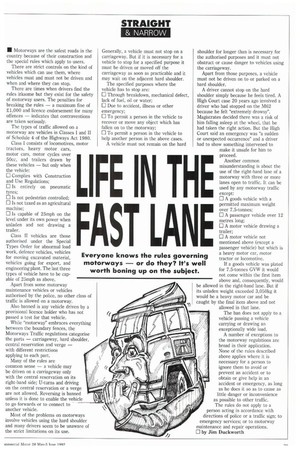FEINT STI
Page 31

If you've noticed an error in this article please click here to report it so we can fix it.
Everyone knows the rules governing motorways — or do they? It's well worth boning up on the subject.
• Motorways are the safest roads in the country because of their construction and the special rules which apply to users, There are strict controls on the kind of vehicles which can use them, where vehicles must and must not be driven and when and where they can stop.
There are times when drivers find the rules irksome but they exist for the safety of motorway users. The penalties for breaking the rules — a maximum fine of £1,000 and licence endorsement for many offences — indicates that contraventions are taken seriously.
The types of traffic allowed on a motorway are vehicles in Classes 1 and II of Schedule 4 of the Highways Act 1980.
Class I consists of locomotives, motor tractors, heavy motor cars, motor cars, motor cycles over 50cc, and trailers drawn by these vehicles — but only when the vehicle: O Complies with Construction and Use Regulations; O Is entirely on pneumatic tyres;
0 Is not pedestrian controlled; CI Is not taxed as an agricultural machine; 0 Is capable of 25mph on the level under its own power when unladen and not drawing a trailer.
Class II vehicles are those authorised under the Special Types Order for abnormal load work, defence vehicles, vehicles for moving excavated material, vehicles going for export, and engineering plant. The last three types of vehicle have to be capable of 25mph as above.
Apart from some motorway maintenance vehicles or vehicles authorised by the police, no other class of traffic is allowed on a motorway.
Also banned is any vehicle driven by a provisional licence holder who has not passed a test for that vehicle.
While "motorway" embraces everything between the boundary fences, the Motorways Traffic regulations categorise the parts — carriageway, hard shoulder, central reservation and verge — with different restrictions applying to each part.
Many of the rules are common sense — a vehicle may be driven on a carriageway only with the central reservation on its right-hand side; U-turns and driving on the central reservation or a verge are not allowed. Reversing is banned unless it is done to enable the vehicle to go forwards or to connect to another vehicle.
Most of the problems on motorways involve vehicles using the hard shoulder and many drivers seem to be unaware of the strict limitations on its use. Generally, a vehicle must not stop on a carriageway. But if it is necessary for a vehicle to stop for a specified purpose it must be driven or moved off the carriageway as soon as practicable and it may wait on the adjacent hard shoulder.
The specified purposes where the vehicle has to stop are: 0 Through breakdown, mechanical defect, lack of fuel, oil or water;
CI Due to accident, illness or other emergency; CI To permit a person in the vehicle to recover or move any object which has fallen on to the motorway;
0 To permit a person in the vehicle to help another person in the above cases. A vehicle must not remain on the hard shoulder for longer than is necessary for the authorised purposes and it must not obstruct or cause danger to vehicles using the carriageway.
Apart from those purposes, a vehicle must not be driven on to or parked on a hard shoulder.
A driver cannot stop on the hard shoulder simply because he feels tired. A High Court case 20 years ago involved a driver who had stopped on the M62 because he felt "extremely drowsy". Magistrates decided there was a risk of him falling asleep at the wheel, that he had taken the right action. But the High Court said an emergency was "a sudden or unexpected occurrence" and a driver had to show something intervened to make it unsafe for him to proceed.
Another common misunderstanding is about the use of the right-hand lane of a motorway with three or more lanes open to traffic. It can be used by any motorway traffic except:
CI A goods vehicle with a permitted maximum weight over 7.5-tonnes; CI A passenger vehicle over 12 metres long; DA motor vehicle drawing a trailer;
0 A motor vehicle not mentioned above (except a passenger vehicle) but which is a heavy motor car, motor tractor or locomotive.
If a goods vehicle was plated for 7.5-tonnes GVW it would not come within the first item above and, consequently, would be allowed in the right-hand lane. But if its unladen weight exceeded 3,050kg it would be a heavy motor car and be caught by the final item above and not allowed in that lane.
The ban does not apply to a vehicle passing a vehicle carrying or drawing an exceptionally wide load.
A number of exceptions to the motorway regulations are broad in their application. None of the rules described above applies where it is necessary for a person to ignore them to avoid or prevent an accident or to obtain or give help in an accident or emergency, as long as he does it so as to cause as little danger or inconvenience as possible to other traffic.
The rules do not apply to a person acting in accordance with directions of police or a traffic sign; to emergency services; or to motorway maintenance and repair operations.
0 by Jim Duckworth




















































































